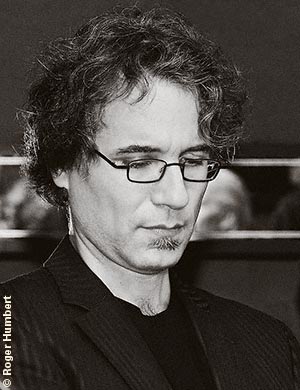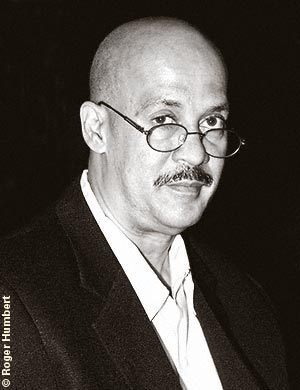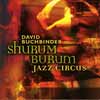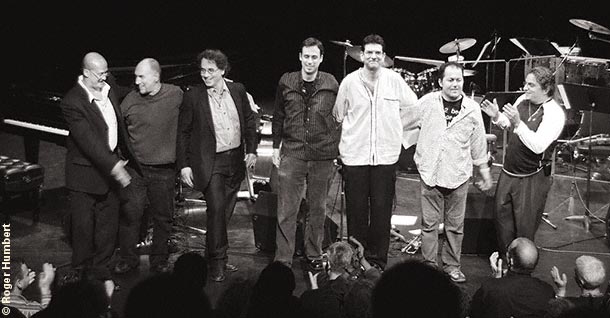| The woman taking the tickets laid out the pertinent facts - the concert will be 70 minutes long, there will be no intermission, the washrooms are over there.
The concert actually lasted 90 minutes. But during that period, time, as dictator of life’s busy schedule or as relentless background ticking, ceased to be. That time was replaced by musical time — tempo and rhythm, time signatures and musical phrases — obliterated by exuberant Klezmer-Afro-Cuban-Jazz. Heads nodded and swayed to the irresistible mix of “bulgar and bembé, sher and son montuno, hora and habanera”. I believe it is safe to say that it was the first time a full concert of Klezmer-Afro-Cuban-Jazz fusion has been played in Toronto, probably in Canada, and I know from my own ears and the standing ovation that it was a tremendous success.
|
|
David Buchbinder told the audience that when the Ashkenaz Foundation approached him to compose new work for the 2006 Ashkenaz Festival, he really wished to create something special. And he did. The long-time leader of The Flying Bulgar Klezmer Band and founder of the Ashkenaz Festival of New Yiddish Culture seized the opportunity to collaborate with Afro-Cuban jazz heavyweight Hilario Durán.
So what do David Buchbinder and Hilario Durán have in common? For one thing, although they are both strongly rooted in what may seem disparate styles, neither is a stickler about roots. They are creative musicians, quite capable of moving beyond their respective traditions. David Buchbinder’s pieces are carefully composed, complete with bursts of precision chaos blowouts, but also, lots of space for improvised solos. Hilario Durán’s pieces are also carefully composed, but also have room for improvised soloing and for exciting percussion punch-outs. They both have the skills of classical composition and musicianship and the sensibility of jazz musicians. They both like to have fun, a big factor in their music.
David Buchbinder and Hilario Durán met and played together for the first time at last year’s Juno Award ceremony. They had both been nominated for the best Contemporary Jazz Album of the Year, Buchbinder for his klezmer-jazz Shurum Burum Circus and Durán (winner of the previous year’s Juno award in the same category) for his Latin-jazz Encuentro en la Habana. Roberto Occhipinti, the bass player in the Odessa/Havana Cu-Klez band, was also up for the award with his Yemaya.
The entire Cu-Klez crew is a talented bunch. Some of its members play regularly with Hilario Durán while others play regularly with David Buchbinder. All lead at least one band of their own. The instrumentation suited the genre-crossing music, using some instruments associated equally with both styles like violin and trumpet, the clarinet, associated more strongly with the Klezmer tradition plus the congas and other percussion essential to Afro-Cuban jazz. The players were David Buchbinder (trumpet), Quinsin Nachoff (tenor saxophone), Aleksander Gajic (violin), Hilario Duran (piano), Roberto Occhipinti (bass), Daniel Barnes (drums) and Mario del Monte (congas, bongos, percussion).
|
|

David Buchbinder |
|

Hilario Duran |
|
|
| In a CBC radio interview, David Buchbinder pointed out that both klezmer and Cuban music share some common origins, especially through medieval Spain, where Arabic, Jewish, Romany, African and of course Spanish music co-existed and from where they dispersed. There is also the commonality of Afro-American jazz influence, similar sonorities, a love of minor keys and the fact that Bulgar rhythm fits neatly into one half of the clave.
The evening started off with David Buchbinder’s “Micomicoma”, very klezmer at first, until the Cuban rhythm settled in underneath. The clarinet then pulled it closer to klezmer. As Hilario Durán played softly, David Buchbinder started a trumpet solo, jazz with a klezmer accent, followed by Durán’s strongly classical piano solo. The klezmer, jazz, Cuban melodic and harmonic content meshed and progressed logically over Cuban rhythm. And then, something new happened. All sound stopped except for drums and percussion as Daniel Barnes and Mario del Monte demonstrated how the rhythms could also mesh and progress out of each other.
The next piece was Hilario Durán’s, “Impressions”. As David Buchbinder explained, this piece represented Durán’s impressions of Jewish music so far, done Cuban-style, of course. After a lone trumpet intro, the piano began a complementary accompaniment, later falling silent under a long-held trumpet note. Then it was the bass that sounded alone for several bars, until all of the band joined in. The piece held a sense of mystery, the band forming and re-forming in various configurations as styles and moods changed. Passionate klezmer violin filled the bars between melodic motifs from the saxophone and trumpet, before a transformation to a blend of classical sound over Cuban rhythm which somehow emerged on some very Jewish horn lines, and was that a Jewish scale on the piano?
“Lailadence” came next, a piece David Buchbinder wrote for his three and a half year-old daughter. Rhythmically and harmonically rich, this was a great syncopated piece which did make you want to dance.
“Romanian Fantasy” was a traditional Jewish piece, arranged by David Buchbinder. A duet of piano and trumpet with the focus shifting between the two. Contained within this piece of contrast, were brash klezmer trumpet lines and soft-held notes, Bach-like piano, darker as well as softer moments followed by a heavy 1/2 rhythm which appeared and disappeared throughout.
David Buchbinder’s “Cadiz” was the most “symphonic” of the pieces with its mood-setting, thunderstorm-approaching bass drum and its bowed bass drone suggesting Moorish Spain; sounds of a funeral dirge and strange minor harmonies under which rhythm slowly led to an outpouring of edgy jazz trumpet from David Buchbinder. Truly, an arresting solo. Quinsin Nachoff followed on tenor with a cleanly executed sharply syncopated solo. The thunder moved back in as Daniel Barnes' sticks flew around the drum kit. Throbbing bass changed to bowed bass and the piece ended in the kind of great klezmer crash that David Buchbinder is so fond of.
Hilario Durán’s “Rumba Judia” was the piece that most featured the talents of Daniel Barnes on drums and Mario del Monte on percussion. David Buchbinder’s “Invectus”, from the Shurum Burum Circus album came next, dedicated to Canadian poet Irving Layton.
The last tune of the evening was a medley of four traditional klezmer tunes arranged by Hilario Durán into a continuum of Jewish dance with a seasoning of Cuba and some Eastern European Roma-klezmer violin from Aleksander Gajic, whose playing throughout the evening was outstanding with its bittersweet dissonance, sharply-cut edges and rhythmic strength.
David Buchbinder and Hilario Durán’s fresh new Cu-Klez is exuberant, epic, stirringly rhythmic, sometimes flamboyant, sometimes beautiful and subtle, and always interesting. Almost entirely an evening of new compositions and innovative arrangements of traditional Yiddish songs, Odessa/Havana, The Klezmer Cuban Connection was an exciting "world première". An ambitious idea brought to fruition, something special for Ashkenaz.
|





